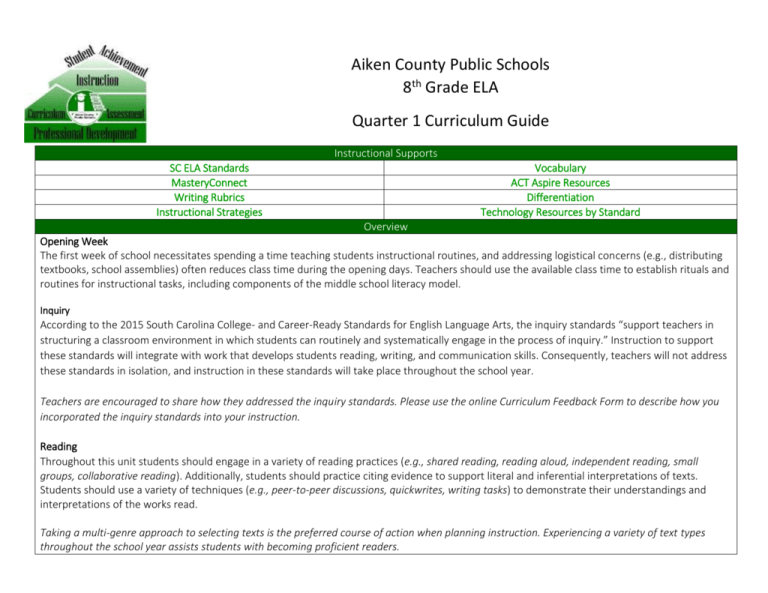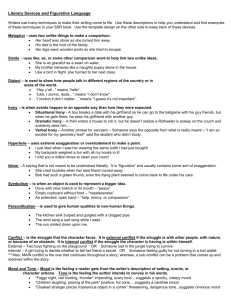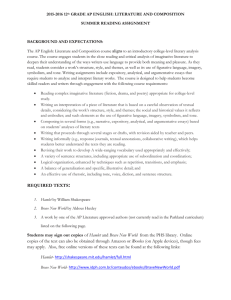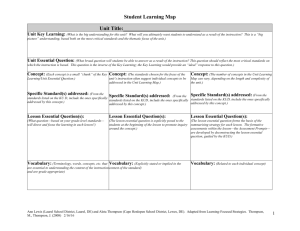Aiken County Public Schools 8th Grade ELA Quarter 1 Curriculum
advertisement

Aiken County Public Schools 8th Grade ELA Quarter 1 Curriculum Guide Instructional Supports SC ELA Standards MasteryConnect Writing Rubrics Instructional Strategies Vocabulary ACT Aspire Resources Differentiation Technology Resources by Standard Overview Opening Week The first week of school necessitates spending a time teaching students instructional routines, and addressing logistical concerns (e.g., distributing textbooks, school assemblies) often reduces class time during the opening days. Teachers should use the available class time to establish rituals and routines for instructional tasks, including components of the middle school literacy model. Inquiry According to the 2015 South Carolina College- and Career-Ready Standards for English Language Arts, the inquiry standards “support teachers in structuring a classroom environment in which students can routinely and systematically engage in the process of inquiry.” Instruction to support these standards will integrate with work that develops students reading, writing, and communication skills. Consequently, teachers will not address these standards in isolation, and instruction in these standards will take place throughout the school year. Teachers are encouraged to share how they addressed the inquiry standards. Please use the online Curriculum Feedback Form to describe how you incorporated the inquiry standards into your instruction. Reading Throughout this unit students should engage in a variety of reading practices (e.g., shared reading, reading aloud, independent reading, small groups, collaborative reading). Additionally, students should practice citing evidence to support literal and inferential interpretations of texts. Students should use a variety of techniques (e.g., peer-to-peer discussions, quickwrites, writing tasks) to demonstrate their understandings and interpretations of the works read. Taking a multi-genre approach to selecting texts is the preferred course of action when planning instruction. Experiencing a variety of text types throughout the school year assists students with becoming proficient readers. Writing Students should write for a variety of purposes throughout quarter one. However, at least one major writing task should involve using the writing process to craft an informational text. The following chart shows the writing focus for each quarter. Quarter One Argument Quarter Two Narrative Quarter Three Argument Quarter Four Informative/Explanatory *Instruction should address using the MLA format, including citations and references, to prepare students for high school. Communication During the first quarter students should begin to analyze and evaluate how speakers communicate their intended messages, and students should practice analyzing and evaluating the speakers in a variety of genres/formats (informative works, persuasive pieces, written, verbal, multimedia, etc.). Cross-content Connections Social Studies In 8th Grade South Carolina History students begin to analyze primary and secondary sources in Unit 1, and they continue that practice throughout the year. Inquiry standard I.3.3 provides additional support for that skill and associated concepts. The Unit 1 and Unit 2 Organizers for South Carolina History (available here and here) provide a list of primary and secondary sources students will explore in that course during the first five weeks of school. Unit 1 of 8th Grade South Carolina History engages students in examining the contributions of various cultures (Native American populations and Spanish, French, and English settlers) to early American cultural, economic, and political environments. Consider having students build upon that knowledge to draw connections to the themes present in “A Quilt of a Country” (or any other suitable text that examines how America has been shaped by the contributions of people from other countries who have settled here). Science During the second half of the first quarter, students study waves in science. Possible cross-content tie-ins include having students apply their knowledge of waves (reflection, transmission, and absorption – 8.P.3A.2) to the narrator’s claims about his hearing in The Tell-Tale Heart. Unit Instructional Considerations This section details skills, concepts, and standards specific to the unit. Note: Teachers may choose to address additional standards during this unit. Inquiry Focus Essential Question: How can I create, ask, and answer questions to expand my learning? I.1 Formulate relevant, self-generated questions based on interests and/or needs that can be investigated. 1.1 Develop a range of questions to frame inquiry for new learning and deeper understanding. KUD for I.1 Know research questions Understand Do Using a process or strategy for Create questions to guide further study or investigation of a topic. creating questions will assist a person with learning more about a topic. Resources and Support Creating Research Questions Video Examples of Questions I.2 Transact with texts to formulate questions, propose explanations, and consider alternative views and multiple perspectives. 2.1 Formulate logical questions based on evidence, generate explanations, propose and present original conclusions, and consider multiple perspectives. KUD for I.2 Know research questions evidence-based explanations Inquiry-based Text Discussion Understand Asking and answering questions about a text supports analyzing and evaluating what a text says and how it conveys meaning. Viewing a text from multiple perspectives is aided by asking and answering questions about the text. Do Ask and answer questions about a text in order to make judgements and consider multiple viewpoints. Reading Focus Essential Question: How does the narrator or speaker affect an audience’s perception of a text? The 2015 South Carolina College- and Career-Ready Standards for English Language Arts call for continuing to reinforce the following standards that were introduced in Kindergarten and Grade 1. RL.P.1/RI.P.1 Demonstrate understanding of the organization and basic features of print. RL.P.2/RI.P.2 Demonstrate understanding of spoken words, syllables, and sounds RL.MC.5 Determine meaning and develop logical interpretations by making predictions, inferring, drawing conclusions, analyzing, synthesizing, providing evidence, and investigating multiple interpretations. 5.1 Cite the evidence that most strongly supports an analysis of what the text says explicitly as well as inferences drawn from the text. KUD for RL.MC.5 Know Understand strategies for developing Texts contain evidence that guide interpretations, making predictions, readers on making inferences and forming inferences, drawing predictions as well as analyzing and evaluating a text. conclusions, and conducting analysis techniques for providing and synthesizing information for a text to form or investigate a variety of interpretations Resources and Support Close Reading of Literary Texts Do Provide evidence from the text to support thinking beyond what is explicitly stated. Show evidence that supports conclusions drawn from the text. RL.MC.9 Interpret and analyze the author’s use of words, phrases, and conventions, and how their relationships shape meaning and tone in print and multimedia texts. 9.1 Determine the figurative and connotative meanings of words and phrases as they are used in text; analyze the impact of specific word choices on meaning and tone, including analogies or allusions to other texts. KUD for RL.LCS.9 Know Understand Do figurative meaning connotation tone context-clues rhyme repetition of sounds (alliteration, assonance, consonance) stanza The meanings associated with the words an author uses shape and affect the meaning and tone of a text. Writers use sound devices to communicate meaning. Authors structure language to communicate meaning and tone. Determine the figurative and connotative meanings of words in a text. Analyze the impact of sound devices (rhyme, alliteration, assonance, consonance) on specific sections of a text. Analyze how an author’s use of language affects meaning and tone. Resources and Support Tone vs. Mood Resource Types of Context-Clues Resource Sound Devices Use in Poetry RI.MC.6 Summarize key details and ideas to support analysis of central ideas. 6.1 Provide an objective summary of a text with two or more central ideas; cite key supporting details to analyze their development. KUD for RI.MC.6 Know objective vs. subjective summarizing strategies key details citing Understand Writing an effective summary consists of pulling out main ideas, focusing on key details, using key words and phrases, and breaking down larger ideas. Resources and Support Summarizing Resource 1 Summarizing Resource 2 Citing Textual Evidence Video Do Write an objective summary of a complex text (two or more main ideas). Include main ideas, key details, and textual evidence in a summary of a text. Analyze how an author develops central ideas. Provide specific textual evidence to support analysis of how an author develops the central ideas in a text. RI.LCS.8 Interpret and analyze the author’s use of words, phrases, text features, conventions, and structures, and how their relationships shape meaning and tone in print and multimedia texts. 8.1 Determine figurative, connotative, and technical meanings of words and phrases used in a text; analyze the impact of specific words, phrases, analogies, or allusions on meaning and tone. 8.2 Analyze the impact of text features and structures on authors’ similar ideas or claims about the same topic. KUD for RI.LCS.8 Know text features and structures (headings, subheadings, charts, graphs, images, etc.) figurative meaning connotative meaning technical meaning context-clues Understand Authors employ text features and structures to assist readers. The meanings associated with the words an author uses shape and affect the meaning and tone of a text. Authors structure language to communicate meaning and tone. Do Identify text features and explain how they support an author’s ideas or claims. Determine the figurative and connotative meanings of words in a text. Analyze how an author’s use of language affects meaning and tone. Resources and Support Expository Text Feature Walks Types of Context-Clues Resource Writing Focus Essential Question: How can using a multi-step process help with writing an informative/explanatory text? W.MC.1 Write arguments to support claims with clear reasons and relevant evidence. 1.1 Write arguments that: a. introduce claims, acknowledge and distinguish the claims from alternate or opposing claims, and organize the reasons and evidence logically; b. use relevant information from multiple print and multimedia sources; c. support claims using valid reasoning and a variety of relevant evidence from accurate, verifiable sources; d. use an organizational structure that provides unity and clarity among claims, counterclaims, reasons, and evidence; e. develop the claim and counterclaims providing credible evidence and data for each; f. develop and strengthen writing as needed by planning, revising, editing, rewriting; g. paraphrase, quote, and summarize, avoiding plagiarism and following a standard format for citation; h. establish and maintain a formal style and objective tone; i. provide a concluding statement or section that follows from and supports the argument. KUD for W.MC.1 Know introductory techniques (startling facts/statistics, asking questions, attention grabbing statements, anecdotes) organizational techniques (chronology, least to greatest, point-by-point, cause and effect, compare and contrast) guidelines for evaluating source credibility claim vs. counterclaim writing process (planning, revising, editing, rewriting) paraphrasing quoting summarizing plagiarism citation format (MLA) transition techniques (words, phrases, and sentence structures; internal transitions within paragraphs) concluding techniques (summary, frame/circle technique, call to action, asking questions) Understand Crafting an effective argument involves using the writing process and employing genre-specific techniques. Do Write an argument that supports claims with reasons and evidence, employs effective introductory and closing techniques, uses an appropriate organizational structure, supplies supporting evidence from credible sources, and follows a format for citations and references. Resources and Support Argumentative Student Sample 1 – Process writing – from achievethecore.org Argumentative Student Sample 2 – Process Writing – from achievethecore.org Argumentative Prompt 6-12 – On-Demand Writing – from achievethecore.org Argumentative Student Sample – On-Demand writing – from achievethecore.org Choosing the Best Verb: An Active and Passive Voice Minilesson – from readwritethink.org Writing Persuasive Letters Organizing Writing Beginnings and Endings W.L.4 Demonstrate command of the conventions of standard English grammar and usage when writing or speaking. When writing: a. show knowledge of the function of gerunds, participles, and infinitives and their functions in particular sentences; b. form and use verbs in the active and passive voice; c. form and use verbs in the indicative, imperative, interrogative, conditional, and subjunctive mood; d. recognize and correct inappropriate shifts in verb voice and mood. KUD for W.L.4 Know gerunds participles infinitives active voice passive voice verb mood (indicative, imperative, interrogative, conditional, and subjunctive) shifts in voice/mood Understand Gerunds, participles, and infinitives perform specific functions in sentences. The active voice emphasizes the subject of a sentence. The passive voice emphasizes the object of a sentence. Verb moods convey specific meaning. Maintaining consistent verb voice and mood maintains clarity. Resources and Support Do Use gerunds, participles, and infinitives to vary sentence structure when writing. Use the active and passive voice appropriately when writing. Employ a verb mood appropriate to the writing situation. Avoid shifts in verb voice and mood when writing. Verb Mood and Tense Resource Choosing the Best Verb: An Active and Passive Voice Minilesson – from readwritethink.org Active/passive Voice Video (3:24) Purdue OWL Exercise Pages Communications Focus Essential Question: How do speakers communicate their messages? C.MC.1 Interact with others to explore ideas and concepts, communicate meaning, and develop logical interpretations through collaborative conversations; build upon the ideas of others to clearly express one’s own views while respecting diverse perspectives. 1.1 Prepare for and engage in conversations to explore complex ideas, concepts, and texts; build coherent lines of thinking. 1.2 Participate in discussions; share evidence that supports the topic, text, or issue; connect the ideas of several speakers and respond with relevant ideas, evidence, and observations. 1.3 Apply effective communication techniques based on a variety of contexts and tasks. 1.4 Engage in a range of collaborative discussions about grade appropriate topics; acknowledge new information expressed by others and when necessary modify personal ideas. 1.5 Consider new ideas and diverse perspectives of others when forming opinions; qualify or justify views based on evidence presented regarding a topic, text, or issue. KUD for C.MC.1 Know procedures for effective collaborative discussions active listening strategies techniques for asking clarifying questions Understand Effective collaboration discussions involve following established procedures, listening actively, respecting the perspectives of others, building upon the ideas of others, and reviewing/reflecting upon the ideas expressed. Resources and Support Collaborative Discussion with Text-based Evidence Example Do Participate in collaborative discussion to build and extend knowledge of grade appropriate topics and texts. Supplemental Resources Use ‘Ctrl + Click’ to follow links (in blue). Several of the resources below align with Common Core standards. However, the skills and concepts they address align with the 2015 South Carolina College- and Career-Ready Standards for English Language Arts. Collections Resources My Favorite Chaperone pg. 3 Electronic summary cards for My Favorite Chaperone – from studystack.com Bonne Année pg. 31 The Latehomecomer pg. 53 New Immigrants Share Their Stories pg. 71 The Tell-Tale Heart pg. 89 Scary Tales pg. 99 What is the Horror Genre? pg. 125 Short Story - The Monkey’s Paw pg. 105 Close reading questions for My Favorite Chaperone – from Broward Schools Lesson plan for Bonne Année – from VIF’s Learning Center Directed Listening-Thinking Activity for The Tell-Tale Heart – from readwritethink.org Motivation of a Murderer: A Close Reading of The Tell-Tale Heart – from cpalms.org Text-dependent Questions and Lesson Plan – from achievethecore.org User Beware: Foreshadowing and Morals in “The Monkey’s Paw” – from cpalms.org Reading Resources ACPS Strategies Page – A regularly updated collection of teaching strategies applicable to multiple grade levels ACPS Vocabulary Page – Tier II words, roots and affixes, and vocabulary strategies







